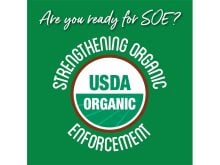The danger of livestock bloat caused by grazing alfalfa has been deflated thanks to a new variety developed by Agriculture Canada scientists.
The new alfalfa is called Low Initial Rate of Digestion or LIRD-4 and it is expected to save the cattle industry millions of dollars a year.
Grazing alfalfa-grass pasture is desirable because cattle gain weight 50 percent faster than if eating grass alone. But because of the danger of cattle dying from bloat when eating alfalfa, the use of mixed pastures has been held back.
Read Also

U.S. bill could keep out Canadian truckers
The Protecting America’s Roads Act, which was tabled in the U.S. House of Representatives at the beginning of October, would “rid the country of illegal immigrant commercial truck drivers and ineligible foreign nationals.”
The key to the new variety is its slow digestion rate, said Bruce Coulman, head of the forage crops section at the Agriculture Canada research centre in Saskatoon.
“Alfalfa has a very rapid breakdown when it enters the rumen,” he said.
“You get a rapid release of bloat-causing material … . Bacteria and other micro-organisms attach themselves to the material and produce sort of a slimy, foamy material which traps the gas.”
Given that an animal eating alfalfa can produce 10-20 litres of gas a minute, if this can’t escape through belching, a dangerous situation could develop quickly. Cattle can be protected from bloat by treating them with the drug poloxalene, an antifoaming agent.
But almost 20 years ago, Agriculture Canada scientist Bernie Goplen decided to look for a better alternative – an alfalfa that breaks down slowly. He used traditional selection techniques in a simple, but time consuming process. Starting in 1979, the leaves from more than 1,000 plants were tested for digestion speed.
Leaves from each plant were put in a small nylon bag and placed for four hours in the rumen of cattle that had been fistulated, that is, with a hole cut into their sides and a removable plug inserted to retrieve the plant material.
The plants producing leaves slowest to digest were selected and crossed to produce the next cycle of plants. Over the next few years, the process was repeated three times.
The fourth generation plants, at the vegetative stage of growth, had initial digestion that was about 85 percent of the control variety, Beaver.
“So the question was, is this enough to prevent bloat or reduce it?” Coulman said.
In the 1990s, the new alfalfa underwent feedlot and grazing trials.
A total of 14 grazing tests of LIRD-4 versus Beaver were done at the Lethbridge, Melfort and Kamloops research stations from 1994 to 1996. In five of the tests, bloat conditions emerged, often called bloat storms.
The reduction in bloat on LIRD-4 compared to Beaver ranged from 40 percent to 88 percent.
“So it’s a bloat-reduced variety, not bloat-safe,” Coulman said.
But since some producers think so highly of grazing alfalfa they are willing to accept a level of bloat loss, the reduced risk will be greatly welcomed, he said.
The forage yield of LIRD-4 alfalfa is about 95 percent that of Beaver. At the vegetative stage of growth LIRD-4 had higher fibre and the same lignin and crude protein as Beaver. At mid-bloom state of growth, its fibre and lignin were slightly higher than Beaver.
The variety has been licensed to Pickseed Canada Inc. and Saskatchewan Wheat Pool for distribution.
Seed stocks are being increased and certified seed should be available in 2000. Pickseed has applied for plant breeder’s rights protection as it develops domestic and international markets for the variety.
Pickseed is collaborating with Agriculture Canada to find the best alfalfa-grass combinations for forage mixtures.
















